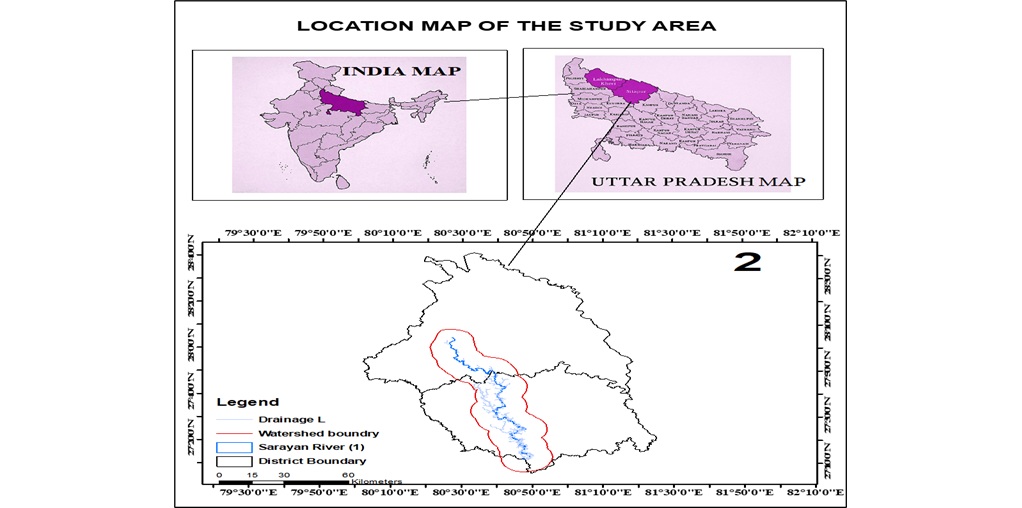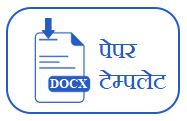Assessing Disappearance and Degradation of Water Bodies in Sarayan Watershed: A Remote Sensing-Based Temporal Analysis

DOI:
https://doi.org/10.54060/a2zjournals.jase.99Keywords:
Water body reduction, Sarayan Watershed, remote sensing, land use change, climate impact, groundwater rechargeAbstract
This study uses remote sensing and GIS tools to evaluate temporal changes in sur-face water bodies in the Sarayan Watershed from 1974 to 2024. Over the last five decades, the number of water bodies in the watershed has dropped dramatical-ly—from 833 in 1974 to only 309 in 2024, a 62.9% decrease. Similarly, the overall area under water bodies has decreased by 32.5%, with several notable tals, such Ludhaura, Lohara, and Bhinsara, completely disappearing. This concerning trend is linked to urbanization, agricultural development, groundwater extraction, sedimen-tation, and climate variability. Spatial research demonstrates growing fragmenta-tion, with water bodies concentrating around natural depressions and river networks. The reduction has had a substantial impact on groundwater recharge, flood regula-tion, local agriculture, biodiversity, and microclimates. Seasonal and small-scale wa-ter bodies, which were formerly critical to rural livelihoods and ecological equilibri-um, have declined or disappeared. These findings highlight the critical need for inte-grated watershed management, the restoration of traditional water bodies, and leg-islative interventions to prevent future degradation. The study provides useful in-formation for environmental planners, regulators, and water resource managers working to ensure long-term water conservation in the region.
Downloads
References
Agarwal and R. D. Garg, "Role of Water Resources in Sustainable Development of India," International Journal of Water Resources and Environmental Engineering, vol. 8, no. 4, pp. 49–56, 2016.
R. Kumar, A. P. Singh, and P. R. Yadav, "Impact of Urbanization on Water Resources in India," Environment and Urbaniza-tion ASIA, vol. 9, no. 1, pp. 125–137, 2018.
R. P. Singh and M. K. Jain, "Watershed as a Unit of Hydrological and Environmental Management," Hydrology Journal, vol. 38, no. 3–4, pp. 47–56, 2015.
R. Sharma and S. Rani, "Ecological Significance of Inland Water Bodies: A Case Study of Punjab," Journal of Environmental Biology, vol. 38, no. 6, pp. 1333–1338, 2017.
A. Mishra and R. Das, "Socio-Cultural and Economic Importance of Water Bodies in India," International Journal of Social Sciences and Economic Research, vol. 4, no. 5, pp. 4034–4043, 2019.
S. Verma and A. Tripathi, "Threats to Urban Water Bodies: A Review," Environmental Conservation Journal, vol. 21, no. 3, pp. 13–21, 2020.
T. M. Lillesand, R. W. Kiefer, and J. W. Chipman, “Remote Sensing and Image Interpretation”, 7th ed. Hoboken, NJ: Wiley, 2015.
P. A. Burrough and R. A. McDonnell, “Principles of Geographical Information Systems”, 2nd ed. Oxford: Oxford University Press, 1998.
S. K. McFeeters, "The Use of the Normalized Difference Water Index (NDWI) in the Delineation of Open Water Features," International Journal of Remote Sensing, vol. 17, no. 7, pp. 1425–1432, 1996.
H. Xu, "Modification of Normalized Difference Water Index (NDWI) to Enhance Open Water Features in Remotely Sensed Imagery," International Journal of Remote Sensing, vol. 27, no. 14, pp. 3025–3033, 2006.
Department of Mining, "District Survey Report of Sitapur," Government of Uttar Pradesh, India, 2021.
S. P. Wani, P. Pathak, L. S. Jangawad, and H. M. Tam, "Integrated Watershed Management for Sustainable Agriculture," Indian Journal of Dryland Agricultural Research and Development, vol. 17, no. 1, pp. 1–8, 2002.
Ministry of Rural Development, Government of India, “Guidelines for Integrated Watershed Management Programme (IWMP)”, New Delhi, 2011.
R. K. Jaiswal, R. Thomas, R. Srivastava, and P. K. Singh, "Application of Remote Sensing and GIS in Watershed Manage-ment: An Overview," Journal of the Indian Society of Remote Sensing, vol. 42, no. 4, pp. 601–610, 2014.
A. K. Singh and A. Bharti, “Hydrological study of Gomti River Basin using geospatial tools,” International Journal of Geo-matics and Geosciences, vol. 6, no. 3, pp. 1543–1550, 2015.
P. K. Rai, “Land use and land cover analysis in Indo-Gangetic plain using remote sensing techniques: A case study,” Journal of the Indian Society of Remote Sensing, vol. 36, no. 4, pp. 289–297, 2008.
S. Sharma and R. Goyal, “Topographical analysis of flood-prone areas in Uttar Pradesh,” Geographical Review of India, vol. 74, no. 2, pp. 135–142, 2012.
A. Singh and S. Sharma, “Assessment of flood hazards using GIS: A case study of Sarayan Basin,” International Journal of Environmental Sciences, vol. 3, no. 5, pp. 2049–2056, 2013.
M. Gupta and R. Yadav, “Soil characteristics and classification of Sarayan watershed,” Journal of Soil and Water Conserva-tion, vol. 12, no. 1, pp. 31–37, 2013.
R. P. Singh, “Soil erosion assessment and land use planning in northern plains,” Indian Journal of Geography and Environ-ment, vol. 17, pp. 27–35, 2012.
N. Singh and A. Bhatnagar, “Climatic classification and monsoonal behaviour in central Uttar Pradesh,” Climate and Envi-ronmental Research, vol. 14, no. 2, pp. 75–82, 2010.
R. K. Mall and A. Srivastava, “Rainfall trends and variability in the Indo-Gangetic Plain,” Journal of Climate Research, vol. 9, no. 3, pp. 109–117, 2014.
A. Mishra and A. Srivastava, “Impacts of monsoonal anomalies on groundwater recharge in the Sarayan basin,” Hydrology Journal of India, vol. 21, no. 2, pp. 63–71, 2016.
N. Rathore and S. Lodha, “Agricultural vulnerability due to climatic variability in Northern India,” Journal of Agricultural Meteorology, vol. 19, no. 1, pp. 46–53, 2017.
S. Kumar and S. K. Jain, “Drainage pattern analysis of Sarayan watershed using geospatial techniques,” Journal of Water Resource and Protection, vol. 7, no. 10, pp. 790–800, 2015.
R. Prasad, P. Tiwari, and A. Sharma, “GIS-based hydrological modeling of Sarayan watershed,” International Journal of Re-mote Sensing and GIS, vol. 8, no. 1, pp. 12–19, 2019.
P. H. Verburg, A. Veldkamp, and L. O. Fresco, “Simulation of changes in the spatial pattern of land use in China,” Land-scape Ecology, vol. 14, no. 4, pp. 379–392, 2009.
W. B. Meyer and B. L. Turner, “Human population growth and global land-use/cover change,” Annual Review of Ecology and Systematics, vol. 23, pp. 39–61, 1992.
E. F. Lambin, B. L. Turner, H. J. Geist, S. B. Agbola, A. Angelsen, J. W. Bruce et al., “The causes of land-use and land-cover change: moving beyond the myths,” Global Environmental Change, vol. 11, no. 4, pp. 261–269, 2001.
B. L. Turner II, D. Skole, S. Sanderson, G. Fischer, L. Fresco, and R. Leemans, “Land-Use and Land-Cover Change: Sci-ence/Research Plan,” IGBP Report No. 35, HDP Report No. 7, 1994.
J. A. Foley, R. DeFries, G. P. Asner, C. Barford, G. Bonan, S. R. Carpenter et al., “Global consequences of land use,” Science, vol. 309, no. 5734, pp. 570–574, 2005.
E. F. Lambin and H. J. Geist, “Land-Use and Land-Cover Change: Local Processes and Global Impacts”, Springer, Berlin, 2006.
P. M. Vitousek, H. A. Mooney, J. Lubchenco, and J. M. Melillo, “Human domination of Earth's ecosystems,” Science, vol. 277, no. 5325, pp. 494–499, 1997.
S. Ghosh and M. P. Sharma, “Urbanization and its impact on water bodies: A GIS based study of greater Hyderabad,” In-ternational Journal of Environmental Sciences, vol. 1, no. 2, pp. 105–114, 2010.
M. Gore, A. Singh, and R. Kumar, "Impact of Urbanization on Water Bodies: Encroachment and Land Use Changes in Indi-an Watersheds," International Journal of Environmental Studies, vol. 77, no. 4, pp. 567–579, 2020.
P. Mishra, S. Sharma, and R. Yadav, "Assessment of Pond Degradation and Its Causes in Rural Watersheds," Journal of Water Resources and Protection, vol. 13, no. 8, pp. 675–688, 2021.
R. Chaudhary, P. Kumar, and S. Mishra, "Wetland Encroachment and Its Impact on Water Security in India," Environmental Science and Pollution Research, vol. 27, pp. 7890–7902, 2020.
S. Singh, R. Kumar, and A. Sharma, "Land Use Change and Fragmentation of Water Bodies in Indian Rural Landscapes," Journal of Land Use Science, vol. 13, no. 2, pp. 198–215, 2018.
Central Ground Water Board (CGWB), "Groundwater Year Book - India 2019-20," Ministry of Water Resources, Govern-ment of India, 2020.
S. Jain, R. Kumar, and P. S. Singh, "Flood Risk Assessment Using Remote Sensing and GIS: A Case Study," Natural Hazards, vol. 98, no. 1, pp. 1–18, 2019.
V. Singh and R. Tiwari, "Impact of Surface Water Decline on Agriculture in North Indian Watersheds," Journal of Agricultur-al Science and Technology, vol. 20, no. 3, pp. 345–355, 2018.
A. Prasad, M. Verma, and S. K. Singh, "Effects of Climate Change on Water Resources in Semi-arid Regions of India," Envi-ronmental Monitoring and Assessment, vol. 191, no. 4, pp. 235, 2019.

Downloads
Published
How to Cite
CITATION COUNT
Issue
Section
License
Copyright (c) 2025 Shreyanshi Singh, Upasana yadav

This work is licensed under a Creative Commons Attribution 4.0 International License.



























